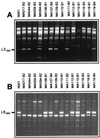Relationship between monokaryotic growth rate and mating type in the edible basidiomycete Pleurotus ostreatus
- PMID: 11472908
- PMCID: PMC93032
- DOI: 10.1128/AEM.67.8.3385-3390.2001
Relationship between monokaryotic growth rate and mating type in the edible basidiomycete Pleurotus ostreatus
Abstract
The edible fungus Pleurotus ostreatus (oyster mushroom) is an industrially produced heterothallic homobasidiomycete whose mating is controlled by a bifactorial tetrapolar genetic system. Two mating loci (matA and matB) control different steps of hyphal fusion, nuclear migration, and nuclear sorting during the onset and progress of the dikaryotic growth. Previous studies have shown that the segregation of the alleles present at the matB locus differs from that expected for a single locus because (i) new nonparental B alleles appeared in the progeny and (ii) there was a distortion in the segregation of the genomic regions close to this mating locus. In this study, we pursued these observations by using a genetic approach based on the identification of molecular markers linked to the matB locus that allowed us to dissect it into two genetically linked subunits (matBalpha and matBbeta) and to correlate the presence of specific matBalpha and matA alleles with differences in monokaryotic growth rate. The availability of these molecular markers and the mating type dependence of growth rate in monokaryons can be helpful for marker-assisted selection of fast-growing monokaryons to be used in the construction of dikaryons able to colonize the substrate faster than the competitors responsible for reductions in the industrial yield of this fungus.
Figures



References
-
- Chang S-T, Miles P G. Edible mushrooms and their cultivation. Boca Raton, Fla: CRC Press, Inc.; 1989. pp. 96–111.
-
- Eger G. Pleurotus ostreatus-breeding potential of a new cultivated mushroom. Theor Appl Genet. 1976;47:155–163. - PubMed
-
- Eugenio C P, Anderson N A. The genetics and cultivation of Pleurotus ostreatus. Mycology. 1968;60:627–634.
Publication types
MeSH terms
Substances
LinkOut - more resources
Full Text Sources

